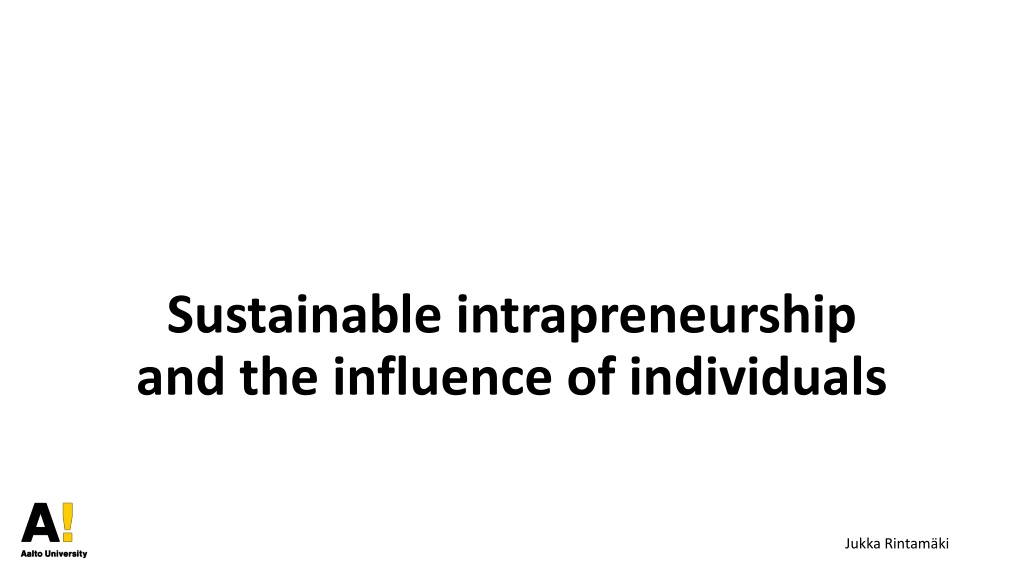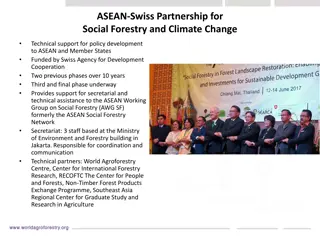Insights into Sustainable Intrapreneurship and Managerial Influence
Delve into the realm of sustainable intrapreneurship and the impact of individual efforts, the role of managers in driving corporate sustainability, the significance of CEO involvement in CSR initiatives, incentivization strategies focusing on ESG, and the nuances of social intrapreneurship for effecting change within organizations. Explore the complexities and dynamics of fostering sustainability within corporate frameworks.
- Sustainable Intrapreneurship
- Managerial Influence
- Corporate Sustainability
- CEO Involvement
- ESG Strategies
Download Presentation

Please find below an Image/Link to download the presentation.
The content on the website is provided AS IS for your information and personal use only. It may not be sold, licensed, or shared on other websites without obtaining consent from the author. Download presentation by click this link. If you encounter any issues during the download, it is possible that the publisher has removed the file from their server.
E N D
Presentation Transcript
Sustainable intrapreneurship and the influence of individuals Jukka Rintam ki
Agenda A few notes on the role of managers in corporate sustainability A guideline for driving sustainability-related change in organizations In-class task
The importance of the role of the CEO A bit of a contested (and complex) issue, but 71% of UN Global Compact signatories state CEO is responsible for CSR CEOs account for 30% of the variance in CSR However, the effect on corporate irresponsibility is smaller! Sources: Wernicke et al., 2021
Most commonly incentivization relates to ESG Traditional focus areas: compliance and risk mitigation 28% of Finnish large listed companies have ESG incentive metrics Denmark, Sweden: 39%, 38% respectively 76% metrics are social, 12% environmental Occupational health and safety 73% of S&P 500 companies tied executive compensation to ESG in 2021 Up from 66% in 2020 Carbon footprint reduction goals increased from 10% to 19% b/w 2020 and 2021 Incentivizing top management for sustainability? Sources: EY, 2022; Spierings, 2022
Incentives Signaling the importance of ESG Responding to investor expectations Achieving ESG commitments Disincentives Difficulty in defining specific goals Concerns about measuring/reporting performance Skepticism about effectiveness in driving performance ESG already covered by existing measures Incentives and disincentives Typically, exec incentivization is ascribed medium importance by CEOs (for achieving ESG outcomes)
What if youre not a CEO? Basics of social intrapreneurship In other words, making change happen without authority
First: Who would you be? Sustainability managers work amidst conflicting pressures and logics Different types of managers face different challenges: Green change maker Green change maker See value in enacting small, incremental changes even in the face of resistance; see themselves as business changemakers Rational manager Rational manager Think through the business case, and many greening opportunities are good for it; see themselves as business managers Committed activist Committed activist Personal values close to the nature; frequent clashes with other departments; difficulties in coping; see themselves as activists first Sources: Wright et al., 2012
Why do employees start driving change at the workplace? They spend a lot of time at work! They are committed, but want to feel good about their workplace If their employer is judged, so are they Useful for top management Employees interests may reflect those of the company s wider audiences
Who: Tempered radicals A person slightly different from the organization s status quo Sees things a bit differently Dissatisfied with some aspects of work/organization Generally committed and identifies with the work/organization strongly Struggle with the tension of acting on their important agendas and a need to fit in with the general culture Believes the best course of action is a carefully considered one, broadly complying with important norms No displays of anger etc. Is on the lookout for quick, easy victories for their cause Sources: Meyerson, 2001; 2004
When: Timing is crucial Consider signals from the inside and outside Stakeholders such as analysts, pundits, NGOs etc. make noise about issues that are relevant for the organization Is a particular labor rights issue a hot topic of discussion? Maybe the time for pushing change is right Do analysts predict hard times for the organization s industry? Perhaps it s best to wait Bottom line: Pay attention, and time accordingly Source: Davis & White, 2015
Framing: Why should anyone listen? Company context matters Consider the organization s culture, values, and priorities Different organizations have different sets of values and norms logics that guide behavior How to study an organization s culture and priorities? Look at the language used at the organization Explore company documents, materials, premises etc. There are tools available this work Even general large language models (e.g. ChatGPT) could work Source: Davis & White, 2015
Building coalitions: Who to involve? It s all about who you know Or getting to know the right people Internal networks Allies, sponsors, buyers , momentum creation External networks Perhaps you know or can find someone with experience for driving similar initiatives? Engaging with facilitative external organizations may help push your cause Media NGOs Source: Davis & White, 2015
Sidenote: Network analysis Analysis of connections between nodes In this case, individuals Consider also the nature of relationships, roles of actors etc. Many tools available NodeXL for MS Excel Easy to learn Especially with the help of AI tools Source: Davis & White, 2015
How: Tools and tactics Should you use corporate comms tools or private ones? A degree of openness might be good for your legitimacy Sensitive issues may warrant a more cautious, secretive approach Shock or no? Framing in alignment with buyers or management s thinking tends to work better than confrontation Formal approaches (language, presentation, setting) tend to be more effective Gives the impression you re serious and willing to take ownership Management of emotions is important Fine line between passion and anger Passion may be convincing, but audience s interpretations are difficult to control Audience may reflect your emotions never display negative emotions Research shows that those who control their display of emotions Feel more comfortable raising issues Receive higher performance evaluations Sources: Ashford & Detert, 2015; Davis & White, 2015
Why things might go south Perceptions of mis-use of work hours If you have time for all this campaigning, are you doing your actual job? Requests for a business-case Danger of stakeholder interpretation as green-washing Are you actually doing this for profit, not because of good intentions? In some industries, compliance systems may pick up your activities Financial services etc. Source: Davis & White, 2015
The formula for issue-selling 1. 2. 3. 4. 5. 6. 7. Tailor your pitch Frame the issue Manage emotions on both sides Get the timing right Involve others Adhere to norms Suggest solutions Source: Ashford & Detert, 2015
What if issue-selling doesnt work? Well, perhaps you re not a tempered radical... Or perhaps you need a change of environment
References Ashford, S. J., & Detert, J. 2015. Get the boss to buy in. Harvard Business Review Harvard Business Review, (JANUARY-FEBRUARY 2015). Davis, G. F., & White, C. J. 2015. The New Face of Corporate Activism. Stanford Social Innovation Review Stanford Social Innovation Review. Meyerson, D. 2001. Radical change, the quiet way. Harvard Business Review Harvard Business Review, 79(9): 92 104. Meyerson, D. E. 2004. The tempered radicals. Stanford Social Innovation Review Stanford Social Innovation Review, 2(2): 14 22. Spierings, M. 2022. Linking Executive Compensation to ESG Performance. Harvard Law School Forum on Corporate Governance https://corpgov.law.harvard.edu/2022/11/27/linking-executive-compensation-to-esg-performance/. Harvard Law School Forum on Corporate Governance. Wernicke, G., Sajko, M., & Boone, C. 2021. How much influence do CEOs have on the company actions and outcomes? The example of corporate social responsibility. Academy of Management Discoveries Academy of Management Discoveries. Wickert, C., & de Bakker, F. G. A. 2018. Pitching for Social Change: Toward a Relational Approach to Selling and Buying Social Issues. Academy of Management Discoveries Academy of Management Discoveries, 4(1): 50 73. Wright, C., Nyberg, D., & Grant, D. 2012. Hippies on the third floor : Climate Change, Narrative Identity and the Micro-Politics of Corporate Environmentalism. Organization Studies Organization Studies, 33(11): 1451 1475.
In-class task: Pushing for change from the ground up Form up in groups or pairs Pick one of the scenarios presented in this slide Devise a plan/strategy for enacting the proposed change (50 mins) Draw on lecture slides and the reading Prioritize which tactics you need the most You have limited time Present the plan to class 5-minute presentation Use your imagination! All scenarios: The CEO is not particularly responsibility- oriented, but not the worst either your run of the mill, fiscally-oriented CEO Scenario 2: You re a sustainability manager at a leading pharmaceutical company. The company has been receiving criticism for the environmental impact of its manufacturing processes. You aim to propose a plan to implement sustainable practices in the production of pharmaceuticals. Scenario 3: You re a sustainability manager for a multinational fashion brand. You worry about the sustainability of your cotton-based garments. You want your company to fix the issue by adopting the GOTS certificate. Scenario 4: You re a sustainability manager at a large IT firm. There are problems in diversity and inclusion: hiring and wages favor majority ethnicity men. You want to advance equity and justice by developing new hiring and promotion policies and practices. Scenario 5: You re a sustainability manager at a global food and beverage corporation. You think the company s use of single-use plastics in packaging is excessive and harmful. Your goal is to lead an initiative to shift the company's packaging strategy towards sustainability by reducing single-use plastics and adopting eco-friendly alternatives. Scenario 1: You re a sustainability manager at an international investment fund. You want to update your policies on sustainable investments. Your job is to convince your boss you should move from exclusion to inclusion in your responsible investment policy.























